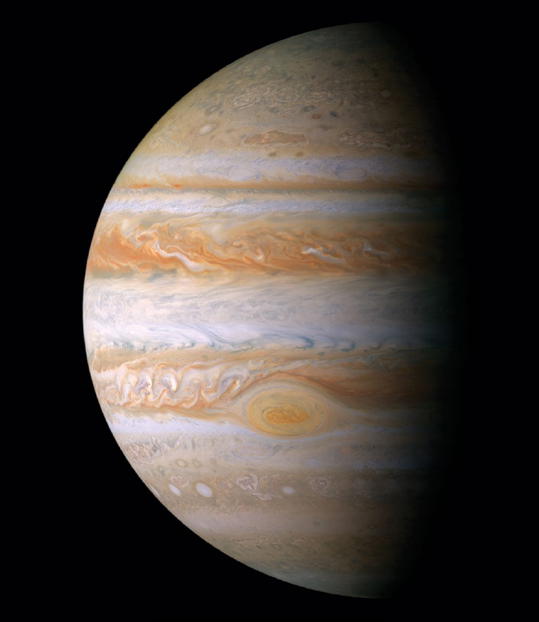c. 4.5 Billion BCE
Jupiter
Our solar system is basically comprised of the Sun (about 99.8 percent), Jupiter (about 0.1 percent), and everything else. Jupiter is truly the king of the planetary realm, with more than twice the mass of all the other planets combined. Sixty-three known moons and a series of faint rings orbit this colossal world. Jupiter’s diameter is 23 Earths across; if it were hollow, more than a thousand Earths would fit inside.
Partly because of its enormous size and its orbital position at the inner edge of the outer solar system (around 5.2 astronomical units), Jupiter is the fourth-brightest object in our night sky after the Sun, Moon, and Venus. Jupiter is also luminous because its visible surface is made up of bright clouds. Indeed, there is no “surface” visible on Jupiter or any of the other giant outer planets—everything we see is cloud or haze, made of exotic and sometimes colorful chemical compounds like methane, ethane, ammonium hydrosulfide, and phosphine. Winds traveling several hundred miles per hour twist the clouds into horizontal belts, and giant Earth-size storm systems, such as the Great Red Spot, have churned for many hundreds of years.
Below the clouds, Jupiter’s pressure and temperature increase dramatically, but the chemistry is, on average, much simpler: Jupiter is about 75 percent hydrogen and 25 percent helium, just like the Sun. In fact, if the Solar Nebula had been bigger and Jupiter had formed with about 50 to 80 times more mass, it would have become a star.
Jupiter’s formation has had a major influence on the architecture of the solar system, perturbing the orbits of the other giant planets, preventing a planet from forming in the region of the main asteroid belt, and gravitationally scattering asteroids and comets on orbits that caused impacts with other planets in the Late Heavy Bombardment. Some objects were even flung into the Kuiper Belt or out of the solar system entirely! Today Jupiter is a gravitational magnet, still occasionally drawing in small bodies such as Comet SL-9, which split up and smashed into its cloud tops in 1994.
SEE ALSO Solar Nebula (c. 5 Billion BCE), Main Asteroid Belt (c. 4.5 Billion BCE), Late Heavy Bombardment (c. 4.1 Billion BCE), Great Red Spot (1665), Kuiper Belt Objects (1992), Comet SL-9 Slams Into Jupiter (1994), Galileo Orbits Jupiter (1995).
True-color mosaic of Jupiter and the Great Red Spot obtained in 2000 by the NASA Cassini spacecraft when it flew past the giant planet for a gravitational assist on its way to Saturn.
